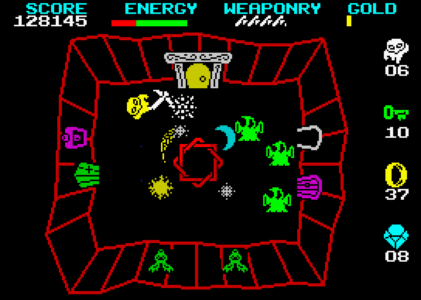Wizard’s Lair, a game that captured the imagination of many ZX Spectrum enthusiasts in the mid-1980s, stands out as a quintessential example of early home computer gaming. Released in 1985 by Bubble Bus Software, this action-adventure title drew players into a labyrinthine world filled with danger, treasure, and mystery. With its intricate design and compelling gameplay, Wizard’s Lair is remembered as a highlight of the ZX Spectrum’s gaming catalog.
Gameplay and Mechanics
Wizard’s Lair follows the adventures of a brave explorer named Pothole Pete, who finds himself trapped in a treacherous maze. The primary objective is to navigate this maze, collect valuable items, and ultimately escape. The game combines elements of exploration, puzzle-solving, and combat, requiring players to use both their wits and reflexes to succeed.
The labyrinth is divided into multiple interconnected rooms, each filled with various hazards such as traps, enemies, and environmental obstacles. Players must carefully navigate these dangers while collecting treasures and useful items. Some items, like keys, are essential for progressing through the maze, while others provide temporary benefits or enhance the player’s abilities.
Graphics and Sound
For its time, Wizard’s Lair boasted impressive graphics. The game utilized the ZX Spectrum’s limited color palette effectively, creating a visually distinct and immersive environment. The character sprites, while simple, were well-animated and added to the game’s charm. Sound effects were minimal but functional, complementing the gameplay without overwhelming the player.

Influences and Legacy
Wizard’s Lair drew significant inspiration from earlier arcade and home computer games, particularly the popular title Atic Atac by Ultimate Play the Game. Both games feature a similar top-down perspective and maze exploration theme. However, Wizard’s Lair introduced unique elements that set it apart, such as its diverse item system and more complex level design.
The game’s legacy is evident in its lasting popularity among retro gaming enthusiasts. Wizard’s Lair is often cited as one of the standout titles for the ZX Spectrum, remembered for its challenging gameplay and innovative design. It has inspired numerous remakes and tributes, highlighting its enduring influence on the gaming community.
If you enjoyed Wizard’s Lair, you might appreciate these similar games that offer a mix of exploration, puzzle-solving, and adventure:
- Atic Atac (1983) – A top-down adventure game by Ultimate Play the Game, where players navigate a haunted castle to collect pieces of the Golden Key.
- Sabre Wulf (1984) – Another Ultimate Play the Game classic, featuring an explorer navigating a jungle maze filled with enemies and treasures.
- Knight Lore (1984) – Known for its pioneering use of isometric graphics, this game by Ultimate Play the Game involves solving puzzles and transforming into a werewolf.
- Underwurlde (1984) – An action-adventure platformer where players guide Sabreman through an underground world, avoiding enemies and finding exits.
- Druid (1986) – An arcade adventure where players control a druid navigating various levels, fighting enemies with spells, and solving puzzles.
- Fairlight (1985) – An isometric adventure game where players explore a castle, solve puzzles, and battle enemies to escape imprisonment.
- Avalon (1984) – A unique action-adventure game where players, as the sorcerer Maroc, navigate a series of dungeons to defeat an evil spirit.
- The Great Escape (1986) – A stealth-based game where players plan and execute an escape from a World War II prisoner-of-war camp.
- Dynamite Dan (1985) – A platform game where players control Dan, collecting items in a mansion to eventually reach and disarm a time bomb.
- Head Over Heels (1987) – An isometric puzzle-platformer where players control two characters with unique abilities, solving puzzles and navigating through a series of rooms.

Wizard’s Lair
Wizard’s Lair remains a cherished part of the ZX Spectrum’s rich gaming history. Its blend of exploration, puzzle-solving, and action set a standard for future games in the genre. For those who experienced it during its heyday, the game evokes fond memories of the early days of home computing. For new players, it offers a glimpse into the roots of modern game design and the timeless appeal of a well-crafted adventure.
Whether you’re a seasoned retro gamer or a curious newcomer, Wizard’s Lair is a title worth exploring. Its intricate mazes, challenging gameplay, and historical significance make it a standout example of the creativity and innovation that defined the early years of video gaming.













